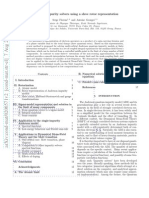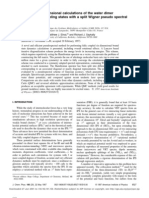Finite Element Simulation of Fully Non-Linear Interaction Between Vertical Cylinders and Steep Waves
Uploaded by
yaseromidi67Finite Element Simulation of Fully Non-Linear Interaction Between Vertical Cylinders and Steep Waves
Uploaded by
yaseromidi6782011209 Subject : Finite element simulation of fully non-linear interaction between vertical cylinders and steep waves 1.
1. Introduction : In the present paper we apply the FEM to analyse the fully non-linear three dimensional interaction between waves and fixed bodies. An iterative method with a preconditioner is used to solve the algebraic equations. A postprocessor based on the recovery technique is adopted in order to improve the accuracy of the finite element solution without increasing the number of elements. A radiation condition is imposed, which is to minimize the effect of the reflection of waves from the truncated boundary of the fluid domain.
Figure 1. Sketch of the problem
2. Governing equation and boundary conditions of fluid motion Assumptions: The viscosity, surface tension and compressibility are neglected.( ) Governing equation: The fluid flow is then irrotational so that a velocity potential exists. Boundary conditions:
where n is the normal vector of the surface pointing out of the fluid domain. 3. Finite Element Formulation At each time step, a mixed boundary value problem has to be solved in which the unknown functions satisfy the Laplace equation in the fluid domain, the Dirichlet condition on the free surface and on the far end, and the Neumann condition on the rigid surface. The FEM is used in which the fluid domain is discretized into a set of small elements and the velocity potential is expressed in terms of a shape function.
Where
is the velocity potential at the nodes.
In this work, linear shape functions are used because this choice makes the calculation of influence coefficients relatively simple.Using the Galerkin method, the Laplace equation and the boundary conditions satisfied by the velocity potential can be discretized in the following form:
This Equation can further be written in the matrix form:
Where
Discretization of the fluid domain: The discretization of the fluid domain into a mesh of small elements is a fundamental part of the numerical procedure. The work presented here is primarily directed towards wave interactions with vertical cylinders. This allows some relatively simple techniques to be used. The fluid domain is first divided into a number of small hexahedra.
Figure 2. Division of a hexahedron.
You might also like
- A Computational Model For Suspended Large Rigid Bodies in 3D Unsteady Viscous Flows XiaoNo ratings yetA Computational Model For Suspended Large Rigid Bodies in 3D Unsteady Viscous Flows Xiao32 pages
- On The Calculation of Normals in Free-Surface Flow ProblemsNo ratings yetOn The Calculation of Normals in Free-Surface Flow Problems14 pages
- 2016_Numerical Analysis of Penetration Problems in Clay With the Particle Finite Element Method_Lluis MonforteNo ratings yet2016_Numerical Analysis of Penetration Problems in Clay With the Particle Finite Element Method_Lluis Monforte9 pages
- On The Accuracy of Finite Difference Solutions For Nonlinear Water WavesNo ratings yetOn The Accuracy of Finite Difference Solutions For Nonlinear Water Waves28 pages
- FINITE ELEMENT ITERATIVE SOLUTION OF SKIN EFFECT PROBLEMS IN OPEN BOUNDARIES - Aiello 125-143 1996No ratings yetFINITE ELEMENT ITERATIVE SOLUTION OF SKIN EFFECT PROBLEMS IN OPEN BOUNDARIES - Aiello 125-143 199620 pages
- Peeren. Stream Function Approach For Determining Optimal Surface CurrentsNo ratings yetPeeren. Stream Function Approach For Determining Optimal Surface Currents17 pages
- Solving The Laplace S Equation by The FDM and BEM Using Mixed Boundary Conditions PDFNo ratings yetSolving The Laplace S Equation by The FDM and BEM Using Mixed Boundary Conditions PDF6 pages
- Galerkin EFGM Method Computational MechanicsNo ratings yetGalerkin EFGM Method Computational Mechanics9 pages
- Advances in The Particle Finite Element Method For Fluid-Structure Interaction ProblemsNo ratings yetAdvances in The Particle Finite Element Method For Fluid-Structure Interaction Problems22 pages
- Finite Element Method For Maxwell's EquationsNo ratings yetFinite Element Method For Maxwell's Equations6 pages
- Phase Field Method To Simulate Fluid FlowNo ratings yetPhase Field Method To Simulate Fluid Flow5 pages
- What Can Go Wrong With Finite Element AnalysisNo ratings yetWhat Can Go Wrong With Finite Element Analysis3 pages
- Numerical Simulation of The Dam Break Problem by General Natural Element Method KemerovoNo ratings yetNumerical Simulation of The Dam Break Problem by General Natural Element Method Kemerovo4 pages
- Computation of Hydration Free Energies A Parameterized Continuum Model: Equilibrium Geometries and Reactive Processes Water SolutionNo ratings yetComputation of Hydration Free Energies A Parameterized Continuum Model: Equilibrium Geometries and Reactive Processes Water Solution8 pages
- Aeroelasticity Calculations Using A Finite Element Method: 2.1. Fluid AnalysisNo ratings yetAeroelasticity Calculations Using A Finite Element Method: 2.1. Fluid Analysis7 pages
- A Numerical Solution of The Navier-Stokes Equations Using The Finite ElementNo ratings yetA Numerical Solution of The Navier-Stokes Equations Using The Finite Element28 pages
- Discretization Considerations in Moving Load Finite Element Beam ModelsNo ratings yetDiscretization Considerations in Moving Load Finite Element Beam Models16 pages
- Application of Nelder-Mead Simplex Method For Unconfined Seepage ProblemsNo ratings yetApplication of Nelder-Mead Simplex Method For Unconfined Seepage Problems10 pages
- Serge Florens and Antoine Georges - Quantum Impurity Solvers Using A Slave Rotor RepresentationNo ratings yetSerge Florens and Antoine Georges - Quantum Impurity Solvers Using A Slave Rotor Representation18 pages
- Fully Coupled Six-Dimensional Calculations of The Water Dimer Vibration-Rotation-Tunneling States With A Split Wigner Pseudo Spectral ApproachNo ratings yetFully Coupled Six-Dimensional Calculations of The Water Dimer Vibration-Rotation-Tunneling States With A Split Wigner Pseudo Spectral Approach18 pages
- Turbulence Modeling -: The k-ε Turbulence ModelNo ratings yetTurbulence Modeling -: The k-ε Turbulence Model13 pages
- Optimal Control of The Classical Two-Phase StefanNo ratings yetOptimal Control of The Classical Two-Phase Stefan25 pages
- Flow Around A Surface Mounted Cubical Obstacle: Comparison of LES and RANS-resultsNo ratings yetFlow Around A Surface Mounted Cubical Obstacle: Comparison of LES and RANS-results10 pages
- Airfoil Aerodynamics Using Panel Methods: Richard L. FearnNo ratings yetAirfoil Aerodynamics Using Panel Methods: Richard L. Fearn15 pages
- Solution of Confined Seepage Problems Below Hydraulic Structures by Finite Element MethodNo ratings yetSolution of Confined Seepage Problems Below Hydraulic Structures by Finite Element Method13 pages
- Flow Around A Circular Cylinder With Fluent: Mech/Chbi 301 Fluid MechanicsNo ratings yetFlow Around A Circular Cylinder With Fluent: Mech/Chbi 301 Fluid Mechanics14 pages
- A Sharp Interface Method Using Enriched Finite EleNo ratings yetA Sharp Interface Method Using Enriched Finite Ele24 pages
- Primary Atomization of A Liquid Jet in CrossflowNo ratings yetPrimary Atomization of A Liquid Jet in Crossflow6 pages
- Rayleigh Wave Correction For The BEM Analysis of Two-Dimensional Elastodynamic Problems in A Half-SpaceNo ratings yetRayleigh Wave Correction For The BEM Analysis of Two-Dimensional Elastodynamic Problems in A Half-Space16 pages
- Level Set Method: Advancing Computer Vision, Exploring the Level Set MethodFrom EverandLevel Set Method: Advancing Computer Vision, Exploring the Level Set MethodNo ratings yet
- Direct Linear Transformation: Practical Applications and Techniques in Computer VisionFrom EverandDirect Linear Transformation: Practical Applications and Techniques in Computer VisionNo ratings yet
- Variational Methods for Boundary Value Problems for Systems of Elliptic EquationsFrom EverandVariational Methods for Boundary Value Problems for Systems of Elliptic EquationsNo ratings yet



























































